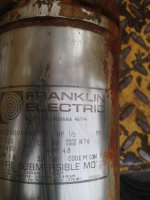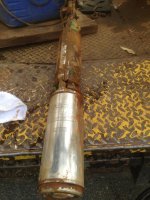I have a lot of respect for Jennifer Strawn. She did a very good job of gathering information for this article. However, she could have gone a little further and ended with a real conclusion. Lets examine each of the 6 ways she found for submersibles failing.
Improper Voltage or Voltage Surges
While it is true that lightning, power surges, and brown outs can cause a submersible motor to fail, I do not believe this is because of improper voltage coming in from the power supply in the majority of cases. It is possible for a direct hit from lightning, power surge, or a brown out to damage only the motor down in the well, but normally it will also get the TV, microwave, and other appliances in the house as well. This makes it obvious that lightning was the culprit, and also makes it obvious that this causes a small percentage of power problems to the motor. It is also rare for lightning to knock out only one phase in a three-phase system.
I would say that more than 90% of the time, power problems to the motor are caused by chaffing, breaking a wire down the well, or one of the three contacts in a three-phase starter arcing out, which will single phase a three-phase motor to death in short order. Cycling the pump on and off, not lightning, is most often the direct cause of all of these voltage failures. However, electronic controls such as VFD’s are much more susceptible to incoming power problems than standard pump systems.
Improper Wire Size or Bad Splice
These problems are usually caused by an incorrect installation. However, cycling of the pump can still exacerbate the problem. Cycling bends the wire and splice back and forth, which can cause a loose or broken connection. As the wire carries more load during pump start, the more times the pump starts, the more times the motor is exposed to low voltage and higher amperage from starting a pump with wire smaller than required.
Poor Water Flow Over the Motor
It is possible for a motor to be set too deeply, which causes the pump to be fed from above and doesn’t let any flow go past the motor. It has been my experience many times that a motor in a “Rat Hole” condition such as this will only last 3-6 hours of running constantly. So usually this problem is discovered before the well is developed, and the pump can be raised above the incoming water level in the well, or a flow inducer shroud can be added to the pump/motor.
However, in rock wells or bottom feeding wells with a high static water level, usually the high static level must be pumped down for a few minutes before the water starts coming from below and cooling the motor properly. In cases where the pump is cycling on/off every couple of minutes, the motor is shut off before any water starts to come from below to cool the motor. Not only is cycling itself a bad thing, but the problem is made worse as the motor never gets any cooling flow past it during the minute or two it is running.
Improperly Programmed Variable Frequency Drives
This is a new one that has been added to the list only recently. I am surprised that they would actually put in writing that a VFD is now one of the biggest killers of submersible motors. It is true that the VFD itself is the actual reason for the many motor failures. However, the VFD is the industries attempt at reducing cycling without having to use a CSV, that would actually make the pump/motors last longer, as they don’t like that. I find it ironic that the actual tool (VFD) they are using to reduce pump cycling is now listed as one of the major causes of motor failures. While the VFD maybe directly responsible for these motor failures, because the VFD is designed to reduce cycling, these failures are still indirectly related to pump cycling.
Pumps Set on Polyethylene Pipe
As this article states, “when the pump turns on and off, the pipe actually stretches and bounces around. This rubs the wire against the well. The wire fails and the pump has to come out”. It is painfully obvious that the fewer times the pump cycles, the fewer problems you will have with rubbing the wire, no matter what type of pipe is used.
Inadequate Tank Size or a Poorly Maintained Tank
While we have discussed this subject in ad nauseam, this article reiterates the problem of cycling. It is a “proven fact” in the industry that “starting and stopping is bad for the pump/motor and every component in the system”. The larger the tank, the fewer times the pump cycles and the longer everything will last. So it stands to reason that completely eliminating cycling during long term uses of water, as with a CSV, would extend the life of the motor even more than a large tank, that only reduces the cycling somewhat.
My Version of the Seventh Deadly Sin
I believe the biggest killer of submersible motors, was the introduction of the automatic re-setting, internal thermal overload. This was an act to intentionally shorten the average life of pumps and motors. I am old enough to remember when all pumps had MANUAL re-set thermal overloads. A little red Klix-On button on the side or bottom of the control box had to be pushed to re-start the pump after an overload condition. Even 2 wire motors came with a little box the size used for a light switch, which had a single Klix-On button to push after an overload condition.
The customer would call when they were out of water. I would instruct them to push the little red button, and let me know if that fixed it. Well then, “hey, yeah the water is back on”. Then I would get a chance to inform them that the tank, pressure switch, check valve, or something was bad, causing rapid cycling that tripped the overload. Repairs were made, and the pump would live much longer.
After the introduction of the “automatic re-setting overloads”, many times the minute of residual water in the pressure tank would mask the fact that the overload was tripping. Even when the water did shut off, it would automatically come back on in a minute or so, and no one called to complain about being out of water. After a month or so of this, the motor was fried and would not restart. Then what would have been a simple service call for a little maintenance turned into a complete replacement of the pump and motor, all because of the “automatic re-setting overload”.
yes I am getting that life with small tanks, and should get more life with a bigger tank but I still want to know what I am going to find on my 9.7 drawdown vs my 25gal drawdown, while everyone else is just trying to cycle the pump less times, I am trying to see if there is really a cut off point of how big of a tank you really need to see the same life.
You are still trying to prove the impossible. Millions of pumps have been installed and decades of experience by many thousands of pump installers has proven that, “The less the pump starts and stops the longer it will last". Not only does cycling shorten the life of pumps and motors, but it also destroys check valves, pressure tanks, pressure switches, relays, capacitors, and “every component of the system”.
Every pump installer will get a few that last 25+ years, but it is not the norm. And in places like Florida, Texas, and California where people use more water, have heat pumps, and even irrigate all year round in many cases, the life of pumps is much shorter than in colder climates where less water is used and there is very little or no irrigation.
In conclusion, Jennifer’s article list the 6 main reasons for pump system failures. Reading between the lines it is easy to tell that the vast majority of times these six things happen because the pump is cycling. And even though rapid cycling is worse than so-called “normal cycling”, ANY cycling is bad for the pump and system.
And good luck getting homeowners to do any preventive maintenance. Most would not even know what they are looking at IF they actually went into the well house and moved all the bicycles, lawnmowers, old paint cans, and junk that gets packed in around the pressure tank over the years. They usually won’t even go check or make a call when the water starts shutting off for a minute at a time because of the automatic overload tripping.
Greatly reducing the cycling with a CSV and adding a Cycle Sensor for protection eliminates the need for any preventive maintenance. The CSV prevents cycling to death the pump, tank, pressure switch, check valve, etc. And on the chance that the tank does lose some air or there is another problem, the Cycle Sensor will let you know before anything is destroyed.
Sorry for rambling. Hope you had enough popcorn.


